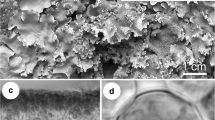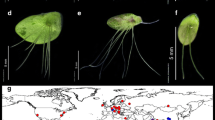Abstract
The cyanobacterium Anabaena has both symbiotic and free-living forms. The genetic diversity of Anabaena strains symbiotically associated with the aquatic fern Azolla and the evolutionary relationships among these symbionts were evaluated by means of RFLP (restriction fragment length polymorphism) experiments. Three DNA fragments corresponding to nif genes were cloned from the free-living cyanobacterium Anabaena PCC 7120 and used as probes. A mixture of Azolla, Anabaena and bacterial DNA was extracted from Azolla fronds and digested with two restriction enzymes. Single-copy RFLP signals were detected with two of the probes in all Azolla Anabaena examined. Multiple-copy RFLP signals were obtained from the third probe which corresponded to a part of the nif N gene. A total of 46 probe/enzyme combinations were scored as present or absent and used to calculate pairwise Nei's genetic distances among symbiotic Anaebaena strains. Phylogenetic trees summarizing phenetic and cladistic relationships among strains were generated according to three different evolutionary scenarios: parsimony, UPGMA and neighbour joining. All trees revealed identical phylogenetic relationships. Principal component analysis was also used to evaluate genetic similarities and revealed three groups: group one contains the cyanobacteria associated with plants from the Azolla section, group two contains those associated with plants from the pinnata species and group three contains those associated with plants from the nilotica species. The same groups had already been identified earlier in a random amplified polymorphic DNA (RAPD) analysis of Azolla-Anbaena DNA complexes, suggesting that the present Azolla taxonomy should be revised. We now suggest a taxonomy of Anabaena azollae that is parallel to such a revised Azolla taxonomy. An Azolla chloroplast DNA sequence derived from Oryza sativa was also used as an RFLP probe on Azolla DNA to confirm the presence of plant DNA in the total genomic DNA extracted from ferns with or without the symbiont. Our results also suggest that total DNA extracted from the Azolla-Anabaena complexes includes both plant and symbiont DNA and can be used equally well for RFLP analysis of host plant or symbiotic cyanobacteria.
Similar content being viewed by others
References
Bai KE-Zhi, Yu SL, Chen WL, Yang SY, Tsui C (1979) Isolation and pure culture of algae-free Azolla and Anabaena azollae. Kexue Tongbao 14:664–666
Berliner MD, Fisher RW (1987) Surface lectin binding to Anabaena variabilis and to cultured and freshly isolated Anabaena azollae. Curr Microbiol 16:149–152
Carrapiço F (1991) Are bacteria the third partner of the Azolla-Anabaena symbiosis? Plant Soil 137:157–160
Caudales R, Antoine AD, Vasconcelos AC (1988) Isolation and characterization of the nitrogen-fixing cyanobacteria from different Azolla species. In:Bothe H, de Bruijn FJ, Newton WE (eds) Nitrogen fixation: hundred years after, Fischer G. Publ. New York, p 232
Caudales R, Wells JM, Antoine AD (1992) Cellular fatty acid composition of symbiotic cyanobacteria isolated from the aquatic fern Azolla. J. Gen Microbiol 138:1489–1494
Caudales R, Wells JM, Antoine AD, Butterfield JE (1995) Fatty acid composition of symbiotic cyanobacteria from different host plant (Azolla) species-evidence for coevolution of host and symbiont. Int J Syst Bacteriol 45:364–370
Dean DR, Jacobson MR (1992) Biochemical genetics of nitrogenases. In: Stacey G, Burris RH, Evans HJ (eds) Biological nitrogen fixation. Chapman and Hall, London, pp 763–834
Eskew DL, Caetano-Anolles G, Bassam BJ, Gresshoff PM (1993) DNA amplification fingerprinting of Azolla-Anabaena symbiosis. Plant Mol Biol 21:363–373
Forni C, Gentili S, Van Hove C, Grilli Caiola M (1990) Isolation and characterization of the bacteria living in the sporocarps of Azolla filiculoides Lam. Ann Microbiol 40:235–243
Forni C, Tel-Or E, Bar E, Grilli Caiola M (1991) Effects of antibiotic treatments on Azolla-Anabaena and Arthrobacter. Plant Soil 137:151–155
Franche C, Cohen-Bazire G (1985) The structural nif genes of four symbiotic Anabaena azollae show a highly conserved physical arrangement. Plant Sci 39:125–131
Franche C, Cohen-Bazire G (1987) Evolutionary divergence in the nif H.D.K. gene region among nine symbiotic Anabaena azollae and between Anabaena azollae and some free-living heterocystous cyanobacteria. Symbiosis 3:159–178
Franche C, Gunning BEG, Rolfe BG, Plazinski J (1987) Use of heterologous hybridization in phylogenetic studies of symbiotic Anabaena strains. In:Verma DPS, Brisson N (eds) Molecular genetics of plant-microbe interactions. Martinus Nijhoff Publ, Dordrecht, the Netherlands, pp 305–306
Gates JE, Fisher RW, Goggin TW, Azrolan NI (1980) Antigenic differences between Anabaena azollae fresh from the Azolla fern leaf cavity and free-living cyanobacteria. Arch Microbiol 128:126–129
Gebhardt JS, Nierzwicki-Bauer SA (1991) Identification of a common cyanobacterial symbiont associated with Azolla spp. through molecular and morphological characterization of freeliving and symbiotic cyanobacteria. Appl Environ Microbiol 57:2141–2146
Haselkorn R (1986) Organization of the genes for nitrogen fixation in photosynthetic bacteria and cyanobacteria. Annu Rev Microbiol 40:525–547
Kim J (1993) Improving the accuracy of phylogenetic estimation by combining different methods. Syst Biol 42:331–340
Komarek J, Anagnostidis K (1989) Trichormus azollae (Strasb) in modern approach to the classification system of cyanophytes. IV. Nostocales. Arkiv Hydrobiol [suppl. 82] Heft 3. Algol Stud 56: 303–345
Ladha JK, Watanabe I (1982) Antigenic similarity among Anabaena azollae separated from different species of Azolla. Biochem Biophys Res Commun 109:675–682
Lin C, Liu CC, Zheng DY, Tang LF, Watanabe I (1989) Re-establishment of Anabaena to Anabaena-free Azolla. Sci China Ser 32:551–559
Lindblad P, Bergman B, Nierzwicki-Bauer SA (1991) Immunocytochemical localization of nitrogenase in bacteria symbiotically associated with Azolla spp. Appl Environ Microbiol 57:3637–3640
Liu CC, Chen Y, Tang L, Zheng Q, Song T, Chen M, Li Y, Lin T (1989) Study on preparation and application of monoclonal antibodies to Anabaena azollae. Sci China Ser B 32:562–569
Lumpkin TA, Plucknett DL (1982) Azolla as a green manure: use and management in rice production. Westview Press, Boulder Colo
Meeks JC, Joseph CM, Haselkorn R (1988) Organization of the nif genes in cyanobacteria in symbiotic association with Azolla and Anthoceros. Arch Microbiol 150:61–71
Moore AW (1969) Azolla: biology and agronomic significance. Bot Rev 35:17–34
Nei M, Li WH (1987) Mathematical model for studying genetic variation in terms of restriction endonucleases. Proc Natl Acad Sci USA 76:5269–5273
Newton JW, Herman AI (1979) Isolation of cyanobacteria from the aquatic fern Azolla. Arch Microbiol 120:161–165
Nierzwicki-Bauer SA, Aulfinger H (1990) Ultrastructural characterization of Eubacteria residing within leaf cavities of symbiotic and cyanobiont-free Azolla mexicana. Curr Microbiol 21:123–129
Nierzwicki-Bauer SA, Haselkorn R (1986) Differences in mRNA levels in Anabaena living freely or in symbiotic association with Azolla. EMBO J 5:29–35
Peters GA, Mayne BC (1974) The Azolla, Anabaena azollae relationship. 1. Initial characterization of the association. Plant Physiol 53:813–819
Petro MJ, Gates JE (1987) Distribution of Arthrobacter sp. in the leaf cavities of four species of the N-fixing Azolla fern. Symbiosis 3:41–48
Plazinski J (1990) The Azolla-Anabaena symbiosis. In: Gresshoff PM (ed) Molecular biology of symbiotic nitrogen fixation. CRC Press, Boca Raton, Fla., pp 51–75
Plazinski J, Francche C, Liu CC, Lin T, Shaw W, Gunning BES, Rolfe BG (1988) Taxonomic status of Anabaena azollae:an overview. Plant Soil 108:185–190
Plazinski J, Zheng Q, Taylor R, Croft L, Rolfe BG, Gunning BES (1990) DNA probes show genetic variation in cyanobacterial symbionts of the Azolla fern and a closer relationship to free-living Nostoc strains than to free-living Anabaena strains. Appl Environ Microbiol 56:1263–1270
Rice D, Mazur BJ, Haselkorn R (1982) Isolation and physical mapping of nitrogen fixation genes from the cyanobacterium Anabaena 7120. J Biol Chem 257:13157–13163
Rohlf FJ (1992) NTSYS-pc: Numerical taxonomy and multivariate analysis system, version 1.70. Exeter Software, New York
Rosen BH, Johnson RC, Fisher RW, Gates JE (1987) Ultrastructural localization of cell surface immunospecificity in Anabaena azollae using indirect fluorescent antibody staining. Am J Bot 74:1060–1064
Saiki RK, Gyllenstein UB, Erlich HA (1988) The polymerase chain reaction. In:Davies KE (ed) Genome analysis:a practical approach. IRL Press, Oxford, England, pp 141–152
Sambrook J, Fritsch EF and Maniatis T (1989) Molecular cloning:a laboratory manual. Cold Spring Harbor Laboratory Press, Cold Spring Harbor, N.Y.
Saunders RMK, Fowler K (1993) The supraspecific taxonomy and evolution of the fern genus Azolla (Azollaceae). Plant Syst Evol 184:175–193
Strasburger E (1973) Uber Azolla. Jena Publ., Leipzig, Germany
Swofford DL (1990) PAUP: Phylogenetic analysis using parsimony, version 3.0. Illinois Natural History Survey, Champaign, Ill
Tang LF, Watanabe I, Liu CC (1990) Limited multiplication of symbiotic cyanobacteria of Azolla ssp. on artificial media. Appl Environ Microbiol 56:3623–3626
Tel-Or E, Sandovsky T, Kobiler D, Arad C, Weinberg R (1983) The unique symbiotic properties of Anabaena in the water fern Azolla. In: Papageorgiou GC, Packer L (eds) Photosynthetic procaryotes: cell differentiation and function. Elsevier Science Publ, New York, pp 303–314
Tel-Or E, Sandovsky T, Arad H, Keysary A, Kobiler D (1984) The unique properties of the symbiotic Anabaena azollae in the water fern Azolla:metabolism and intercellular recognition. In: Veeger C, Newton WE (eds) Advances in nitrogen fixation research. M. Nijhoff/ Dr W. Junk Publ, The Hague, the Netherlands, pp 461–465
Tomaselli L, Margheri MC, Giovanetti L, Sili C, Carlozzi P (1988) The taxonomy of Azolla spp. cyanobionts. Ann Microbiol 38:157–161
Van Coppenolle B, Watanabe I, Van Hove C, Second G, Huang N, McCouch SR (1993) Genetic diversity and phylogeny analysis of Azolla Lam. based on DNA amplification with arbitrary primers. Genome 36:686–693
Van Hove C (1989) Azolla and its multiple uses with emphasis on Africa. FAO, Rome
Van Hove C, De Waha Baillonville T, Diara HF, Godard P, Mai Kodomi Y, Sanginga N (1987) Azolla collection and selection. In: International Rice Research Institute (ed) Azolla utilization. Manila, The Philippines, pp 77–87
Watanabe I, Lin C, Ramirez C, Lapis MT, Santiago-Ventura T, Liu CC (1989) Physiology and agronomy of Azolla-Anabaena symbiosis. In: Skinner FA et al. (eds) Nitrogen fixation with non-legumes. Kluwer Academic Publ Dordrecht, the Netherlands, pp 57–62
Watanabe I, Roger PA, Ladha JK, Van Hove C (1992) Biofertilizer germplasm collections at IRRI. International Rice Research Institute, Manila, Philippines
Young JPW (1992) Phylogenetic classification of organisms. In: Stacey G, Burris RH, Evans HJ (eds) Biological nitrogen fixation. Chapman and Hall, London, UK, pp 43–86
Zimmerman WJ, Lumpkin TA, Watanabe I (1989a) Isozyme differentiation of Azolla Lam. Euphytica 42:163–170
Zimmerman WJ, Lumpkin TA, Watanabe I (1989b) Classification of Azolla ssp., section Azolla. Euphytica 43:223–232
Zimmerman WJ, Rosen BH, Lumpkin TA (1989c) Enzymatic, lectin, and morphological characterization and classification of presumptive cyanobionts from Azolla Lam. New Phytol 113:497–503
Zimmerman WJ, Watanabe I, Lumpkin TA (1991) The Anabaena-Azolla symbiosis:diversity and relatedness of neotropical host taxa. Plant Soil 137:167–170
Author information
Authors and Affiliations
Additional information
Communicated by J. MacKey
Rights and permissions
About this article
Cite this article
Van Coppenolle, B., McCouch, S.R., Watanabe, I. et al. Genetic diversity and phylogeny analysis of Anabaena azollae based on RFLPs detected in Azolla-Anabaena azollae DNA complexes using nif gene probes. Theoret. Appl. Genetics 91, 589–597 (1995). https://doi.org/10.1007/BF00223284
Received:
Accepted:
Issue Date:
DOI: https://doi.org/10.1007/BF00223284




